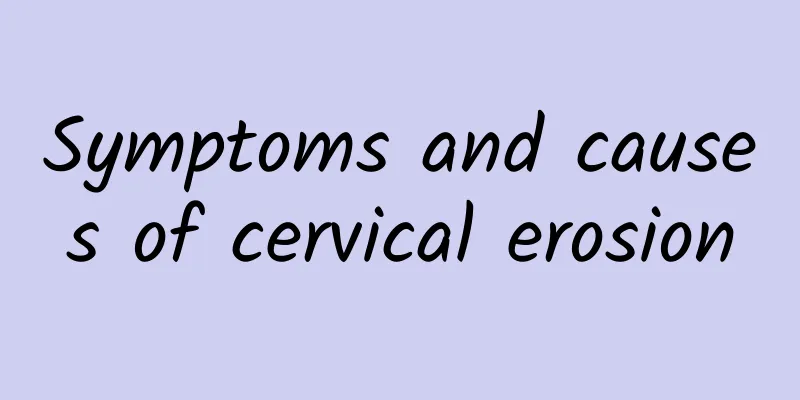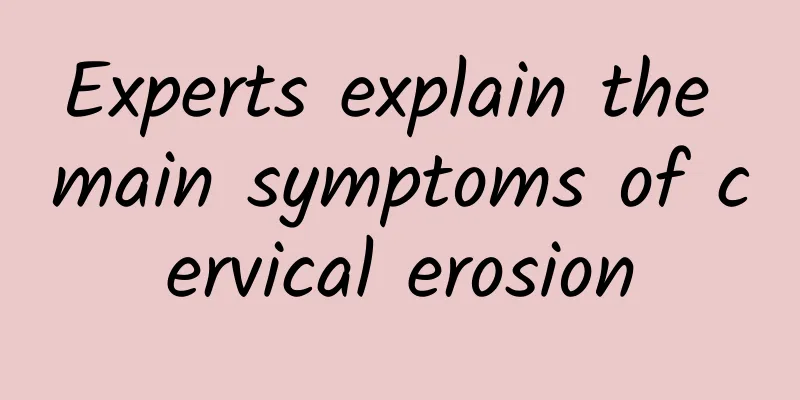Symptoms and causes of cervical erosion

|
Cervical erosion is a common gynecological phenomenon, which is mainly manifested by the eversion of cells on the surface of the cervix, which may be accompanied by symptoms such as increased leucorrhea and contact bleeding. Its occurrence is related to factors such as hormone levels, inflammatory stimulation, and cervical injury. 1. Changes in hormone levels Cervical erosion is closely related to estrogen levels. During puberty, pregnancy, or when taking birth control pills, increased estrogen levels may cause the cervical columnar epithelium to evert, forming an erosive appearance. This situation is usually a physiological change and there is no need to worry too much, but regular examinations are required to rule out other lesions. 2. Inflammatory stimulation Chronic cervicitis is a common cause of cervical erosion. Bacterial, viral or fungal infections may cause the cervical tissue to be in a state of inflammation for a long time, which in turn causes erosion. Common pathogens include human papillomavirus HPV, gonococci, Chlamydia trachomatis, etc. In treatment, antibiotics or antiviral drugs such as azithromycin, doxycycline or interferon should be used against the pathogens. 3. Cervical injury Multiple artificial abortions, birth injuries, or cervical surgery may cause damage to cervical tissue and increase the risk of erosion. Preventive measures include avoiding unnecessary cervical manipulation, paying attention to personal hygiene after surgery, and regular check-ups. For erosions that have already formed, physical therapy methods such as laser, freezing, or electrocautery can be used to promote tissue repair. 4. Lifestyle and environmental factors Long-term use of irritating lotions, frequent sexual intercourse or unclean sexual behavior may aggravate cervical erosion. It is recommended to choose mild cleaning products, avoid excessive vaginal cleaning, and maintain sexual hygiene. In terms of diet, eating more foods rich in vitamins C and E, such as citrus fruits and nuts, can help enhance immunity and promote cervical health. 5. Medical advice If you experience symptoms such as abnormal vaginal discharge, contact bleeding, or lower abdominal discomfort, you should seek medical attention immediately. The doctor will confirm the diagnosis through cervical smear, HPV test, or colposcopy, and develop a personalized treatment plan based on the condition. For physiological erosion without obvious symptoms, no special treatment is usually required, but regular follow-up is required. Although cervical erosion is common, it is necessary to distinguish between physiological and pathological conditions. By adjusting lifestyle habits, actively treating inflammation and regular checkups, cervical erosion can be effectively prevented and managed to maintain female reproductive health. |
<<: Abnormal leucorrhea, smelly lower abdomen pain
>>: How long does it take to get pregnant after laparoscopic surgery for ectopic pregnancy
Recommend
Does vulvar itching affect life expectancy?
There are so many reasons for vulvar itching, and...
How to treat severe cervical erosion in women? Is severe cervical erosion in women serious?
How to treat severe cervical erosion? Cervical er...
What are the main symptoms of Trichomonas vaginitis?
The symptoms of Trichomonas vaginitis are general...
Is it good to have an abortion in three months of pregnancy?
Abortion in the third month of pregnancy requires...
How to diagnose cervicitis
Cervicitis is a common disease among women. It ca...
What harm does the appearance of uterine fibroids cause?
Among the diseases in gynecology, I believe every...
Autoimmune diseases can cause premature ovarian failure and amenorrhea
Premature ovarian failure amenorrhea refers to se...
Threatened abortion without bleeding test
For many pregnant mothers, threatened miscarriage...
Methods of abortion
Methods of abortion: With the development of toda...
Detailed explanation of the treatment of chronic pelvic inflammatory disease
Patients with chronic pelvic inflammatory disease...
How long does it take to get menstruation after ectopic pregnancy surgery?
Surgery is generally a good treatment for ectopic...
Can uterine fibroids be treated with minimally invasive methods? The treatment process of uterine fibroids
Minimally invasive surgery is a common cancer tre...
The use of drugs for threatened abortion should be scientific and reasonable
Threatened abortion reminds expectant mothers to ...
What oral medication is best for treating uterine effusion?
The uterus is the lowest part of the abdominal ca...
How to treat congenital absence of uterus and vagina
How to treat congenital absence of uterus and vag...









